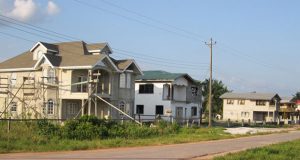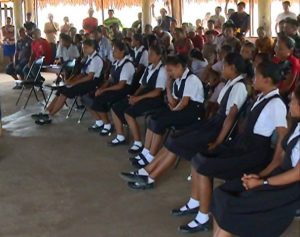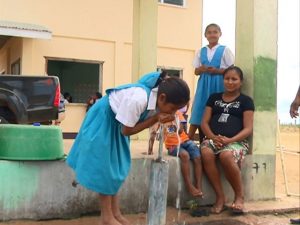
Community development …one of PPP/C Gov’t’s many trademarks
A GINA feature
ACTIVITIES geared at enhancing the status of any community, must be of a certain type and executed with certain specifics in mind. The People’s Progressive Party/Civic (PPPC) Administration is not in any ‘knee-jerk’ approach as it implements long-term plans and thinks in a holistic manner, since a society is about the overall development of its people. Born and bred in the East Coast Demerara village of Buxton, Presidential Adviser on Community Development, Odinga Lumumba, is well qualified to make a contrast of ‘what it used to be’ as against what currently obtains in terms of community development. “When we (PPP/C) came to power, there was the absence of many social activities in Buxton and the infrastructure was not well done … there was the absence of modern infrastructure, like the roads were not kept, and the water system was almost nil, (and) people had to travel long distances for water (and), if they did not travel long distances for this water, only at certain periods of the day or night, they would get access to water (as) either it was the lack of power or the transmission system that was
dysfunctional.”
Inherent in this comparison are a number of philosophical underpinnings where the PPP/C is concerned in relation to nation building.
Holistic approach
Education has enjoyed an unprecedented boom in the recent past, both in investments and the concomitant results. Mr. Lumumba recalled the school system, where Buxton was very problematic, as “the schools were old and rundown, there was lack of books in the schools, and the health system was non-functional.” He also alluded to the fact that there was no community centre and the playground was in disarray.
According to him, the PPP/C Government had to go about fixing all of these things, and now, the advisor noted, people are seeing a complete change. Mention was made of the Tipperary Hall, constructed at a cost of over $50M, so now people can have public meetings, dances, lessons, classes and musical activities. He mentioned the water system, where “today people can have water in Buxton, not only in the yard, but also in the actual home.” He stated that “the playground is now functional, the fence is up and the residents have a basketball court, with one or two small pavilions.” His enumeration went on to include the health centre, which is very functional; visits are now being made by doctors and a nurse permanently placed to offer services.
The Presidential Adviser did not limit himself to Buxton; he added Linden as another example of the holistic approach of the PPP/C to community development. Linden, he recalled, had various similarities: the road system was in disarray; the water was brown; and there was no proper housing. However all of this is history. It was because the Government went about correcting those situations. The PPP/C distributed thousands of house lots in Linden, but before it did so, it ensured that the social climate was present so that Lindeners were able “to rebuild, reconstruct or rehabilitate or construct brand new houses, particularly in Amelia’s Ward. (Now) the water system … we have put in a purification plant in Linden, we have built a new hospital in Wismar, new schools and so all those things come and we have built several basket ball courts. You cannot deal with the enhancement of the community, and don’t deal with youths in sports and culture, so we have done that in most communities.”
Housing
Speaking to the issue of housing, he recalled the overt absence of any proper distribution for housing under the People’s National Congress regime, and the state of the economy, and how the interest rate was remarkably high—over 30 percent. “One of the biggest things for us in community development was developing the community in the sense of repairing and fixing the housing stock, and if you go from community to community today, whether it be Essequibo or East Coast, Berbice or the East Bank, you will see spanking new houses, and very large housing schemes, where there are hundreds of new homes, whether it be Tuschen, La Parfaite Harmonie, Diamond, Bush Lot, wherever you go, these are examples of community development.”
According to the adviser, it is not just about the booming of the housing sector all across the country, nor the elaborate architectural and aesthetic display of the actual houses; it is about a robust economy that allowed for infrastructural inputs, lower bank rates and more earning power. It should be recalled that pre-1992, Guyana was an impecunious nation; 94 cents of every dollar had to go towards the servicing of debts incurred by the previous rÉgime, and with nothing to show for it.
So by dint of hard and prudent work, the country has turned around and now, “We have built brand new communities, and we have taken historical old communities and rejuvenated them by providing access to housing and low interest housing loans.”
Hinterland communities
Mr. Lumumba reminisced on the reality that for years, “our Amerindian brothers and sisters were treated as third class citizens…as they lacked access to education; potable water; proper health services and they also lacked access to the tools of civilisation.” This has changed, he pointed out.
He noted that the PPP/C understood and recognised that one of the fundamental priorities for any good government is to have equality throughout the regions, and to ensure that every race be able to function on a level playing field. This kind of thinking led the PPP/C into putting systems in place to allow for hinterland communities to close the existing gap. This was not done in a haphazard manner either. The PPP/C started with education.
Many Amerindians are now studying to become doctors and medical technicians and “there are several programmes which train them to become teachers, so that they can go back to their communities and be teachers, and nothing is better than when you have your own community people coming back, in a positive manner, to instill education and growth to a particular community.”
The scholarship programmes, for children to attend school on the coast, and the University of Guyana, the latter through the Public Service Ministry, are meant to cultivate the growth and development of all the Amerindian communities, he stated.
At the foundational level, the Government built numerous schools in the hinterland, and in cases where schools could not be built in a specific community, a system of dormitories was set up, so that the young people were able to move from one community to another, so that they can have access to not just a school, but also a place to stay and with the providing of meals.”
It did not stop here, as in many areas, “we have improved the life of the Amerindian communities; for example, in some areas we have given them access to laptops, but that comes because we have introduced solar energy in many communities.”
At the macro level, the PPP/C is now improving the airstrips, so the Amerindians can have access to other communities, they can travel much more freely and this means that the communities are no longer isolated.
Overall, PPP/C has made great progress in enhancing the lives of Guyanese. It has gone past the bare minimum as most Guyanese, irrespective of locales, are living in very wholesome conditions.



